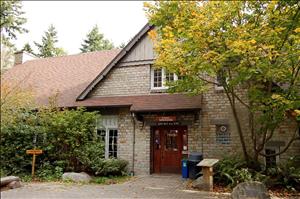Camp William G. Long Nature Center, Camp Long for short, is a 68-acre Seattle city park, located at 5200 35th Avenue SW in West Seattle. The recreational area was created during the Great Depression by the Works Progress Administration (renamed the Work Project Administration in 1939), established to provide millions of American with gainful employment through public works projects such as creating, upgrading, and maintaining local parks.
In the Woods
In 1935, the City of Seattle purchased approximately 210 acres of unimproved land in West Seattle from the Puget Mill Company, a large-scale property developer, for $40,000. The Seattle City Council wanted the wooded tract, located on 35th Avenue SW between SW Genesee and SW Brandon Streets, to establish a municipal golf course, athletic field, and stadium. It would be essentially a WPA undertaking, paid for with city and federal funds. Before the end of 1935, WPA crews were busy cutting down trees, clearing away thousands of stumps, and contouring the land into golf links.
There were some 68 acres of trees and brush on the west side of the property that were unsuitable for a golf course. In 1936, Archie E. Phelps, then president of the Seattle Parks Board and a West Seattle resident, observed that the unusable hillside was about to be cleared and terraced by the WPA workers. Phelps immediately contacted William G. Long, a King County Superior Court Judge overseeing juvenile cases, and together they appealed to the Seattle City Council to preserve this forested section as a recreational area and camp ground for youths. "This could be a place where youngsters, for the price of a bus token, could camp overnight, and learn woodcraft and a love for the great outdoors," they argued ("Benevolent Larceny Built Youth Camp"). The petition was wholeheartedly backed by the city’s youth-oriented organizations, including the Boy Scouts, Girl Scouts, Camp Fire Girls, YMCA, and YWCA.
The city council enthusiastically supported the plan to create a youth camp on the essentially useless property. As a part of the municipal golf course and recreational center project, the plan received funding from Seattle’s city treasury, the Seattle Parks Department, as well as the federal government. It was during the Great Depression, however, and mainly due to periodic funding issues, rather than a lack of manpower, the camp project took some four years to complete.
Although specific projects, such as construction of the main lodge, were sometimes delayed, work on the youth camp progressed. Clark E. Schurman (1882-1955), a renowned mountaineer and longtime Scout Master, designed the camp’s layout, which included a 25-foot-high, man-made, climbing rock and simulated glacier. Built by WPA workers, the unique structure was intended to introduce youths to mountaineering skills. Seattle Parks Department hired Schurman as camp director, a position he held for more than seven years.
In April 1941, work on the lodge resumed. Its construction had been postponed more than one year, due to a shortage of skilled workers who were being assigned to national defense programs. In any event, the project was completed and the unique facility received national recognition. After some debate, the Seattle City Council decided the camp should be named after Judge Long, its most ardent supporter.
Dedication Ceremony
On Saturday afternoon, November 8, 1941, the Seattle Parks Department held a dedication ceremony on the parade ground behind the lodge. Some 2,000 citizens attended, including Seattle Mayor William Earl Millikin (1891-1970); the state’s WPA Administrator, Carl W. Smith; the Seattle Parks Board president, James A. Gibbs; King County Commissioner Archie E. Phelps (1898-1954); and several other city officials and dignitaries. Judge Long was the honored guest and delivered the keynote address. Afterward, the public was encouraged to tour the camp and watch demonstrations of mountaineering techniques on Monitor Rock, Clark Schurman’s specially designed, artificial mountain peak. Following his death in Urbana, Illinois, on January 28, 1955, the "practice peak" was renamed Schurman Rock.
Judge Long, who presided over the King County Juvenile Court for 31 years, died in Seattle on January 3, 1974, after a prolonged illness. A bronze plaque outside the Camp Long Nature Center Lodge, placed November 8, 1975, pays tribute to his efforts in creating the recreational facility. It reads: "In Honor of Judge William G. Long, 1895-1974: Through whose efforts and dedication this camp was established for Seattle’s youths, that they might learn camping and climbing skills in a unique setting within the city." An outstanding example of enlightened municipal planning, Camp Long is one of Seattle’s best-kept secrets, and today [2024] attracts more than 50,000 visitors per year, desirous of an opportunity to commune with nature and enjoy the park’s special attractions.
On Monday evening, November 11, 2024, a fire set by one or more arsonists swept through Camp Long Lodge, causing an estimated $1.2 million in damage. Reported The Seattle Times: "Sixty firefighters – including seven engines and three ladder trucks – responded. After first searching the building’s basement, firefighters retreated after finding a hole in the floor on the first story ... The flames left the front of the lodge scorched and a gaping hole in its roof" ("Arson Damages ...").

